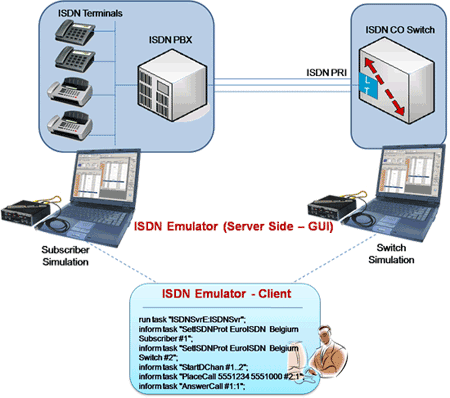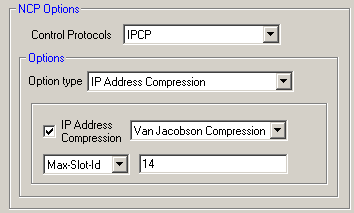GL Enhances T1 E1 Analyzer Products and Software - Ver 5.18
Welcome to GL's Newsletter covering the latest products, features, and enhancements to our versatile T1 E1 Analyzer product line (Ver 5.18).
Major features and enhancements include:
- Scripted ISDN PRI Emulation in addition to existing GUI PRI ISDN Emulation
- Call capture based on traffic type triggering, e.g. tones, digits, voice, or modem
- ML-PPP Emulator now supports Van Jacobson Compression and IP Header Compression in IPCP Configuration as per RFC 1144 and RFC 2507
- All HDLC based protocol analyzers now support decoding of frames with Frame Check Sequence of 32 or 16 bits
- ISDN PRI protocol analyzer now supports ANSI decode T1.607
- ISDN PRI protocol analyzer now supports MLPP (Multi Level Precedence and Pre-emption)
- GSM Analyzer now supports decoding of SMS layer i.e SMS-CP, SMS-RP, and SMS-TP protocols
- TRAU Toolbox™ and analyzer has been enhanced to support DTX
New Applications
WCS ISDN Emulator:
The application is used for performing complete ISDN switch and subscriber emulation. The functions that can be performed using client-server software are:
- Configuring the ISDN layer parameters, called/calling numbering plan/type, type of ISDN service,
- Placing and accepting call for each timeslot or for the whole trunk
- Logging call records for complete or incomplete calls
- Simple NFAS setup for T1

For comprehensive understanding of the product, please visit WCS ISDN Emulator web page
Enhancements:
Significant enhancements have been introduced to the following applications:
If you have our products or are interested in these features, please download or enquire about these enhancements.
Multiple Call Capture:
Call Capture Application (CCA) now includes a new feature to trigger capturing of calls based on various types of traffic in addition to trigger capturing based on signaling, tone, ISDN calls, and SS7 calls. The traffic activated trigger includes:
- Voice based on a minimum power level
- Tones of specified frequency - Ring back tone, Dial tone, Busy tone, and DTMF digits
- Fax traffic - V.32 / V.17 >2400bps, V.27 ter @ 4800bps, V.27 ter @ 2400 bps, V.29,
- Modem traffic - V.22 forward/reverse channel, V.34 & V.90 uplink, Binary V.90 downlink, FSK
Detecting the above types of traffic requires use of the traffic classifier. A 2048 byte (256 ms) block of data is sent to the traffic classifier. The traffic classifier determines if the data is one of the accepted types of traffic. If the condition is met, capture of the traffic data commences.
Unlike the other traffic options, triggering on voice traffic can be fine-tuned to the power level of the voice data.Setting the voice power level can be used to filter out weak or undesirable voice data.
There is also an option "Any Signal".Selecting this feature bypasses the traffic classifier and detects the power level of the data.If it exceeds the input data in "Any Power Level", then capture commences.
- Stopping Traffic or "Any Signal" Capture
Setting the "Silence Options" slider allows for hang-ups during the capture of traffic or "Any Signal" data. For example, if DTMF traffic is being captured, and then non DTMF data is detected, capture continues until the hang-up time limit set by "Silence Options" is exceeded. If the data reverts back to DTMF, the capture continues as it was before the hang-up.
If the hang-up time limit is 400 milliseconds, only one hang-up is allowed before capture is terminated. Each buffer of data is of size 2048 bytes (256 ms).
- Traffic Algorithm
The traffic classifier uses four different algorithms to choose from: Linear, Quadratic, Hybrid, or Hybrid Filtered.
- Linear: This algorithm is quicker to computer
- Quadratic: This gives better accuracy but need more time
- Hybrid: It is a combination of linear and quadratic, and the most reliable
- Hybrid Filtered: This eliminates misclassifications, for example, voice with many periods of silence
The "Hybrid" algorithm is used by default in the Multiple Call Capture.
For comprehensive understanding of the enhancements introduced to the product, please visit Multiple Call Capture Application web page
Multi-Class MLPPP Emulator
The application supports the Van Jacobson Compression and IP Header Compression in IPCP Configuration as per RFC 1144 and RFC 2507.

For comprehensive understanding of the enhancements introduced to the product series, please visit Multi-Class MLPPP Emulator web page
Protocol Analyzers:
The following are the important enhancements introduced to the protocol analyzer products:
- All HDLC based analyzers now support decoding of frames with FCS 32 or 16 bits
- ISDN Analyzer
- Supports new ISDN ANSI decode - T1.607 (Specification)
- MLPP (Multi-Level Precedence. and Pre-emption) procedures for:
ISDN ANSI decode - T1.619 and T1.619a (Specifications)
ITU implementation - Q.955.3 (Specification) and
Facility Information Element - Q.932 (Specification) - GSM Analyzer
The analyzer now supports decoding of SMS layer i.e SMS-CP, SMS-RP, and SMS-TP Protocols
- MLPPP Analyzer and Emulator
The analyzer is enhanced and now it has been added with the following important features:
- MLPPP Analyzer now supports decoding of frames with two MLPPP layers and frames with CRC 32, or 16 bits options
- Filtering capability in analyzer is enhanced with inclusion IPHC, IPHC compressed TCP, IPHC compressed non-TCP, IPHC full header, VJ Compressed TCP/IP, and VJ Uncompressed TCP/IP layers
- New columns are added that display the information for VJContext ID,IPHC TCP CID, IPHC Non-Tcp CID[8 bit], IPHC Non-Tcp CID[16 bit], IPHC Generation, Src IPAddress[IPHC Cmp IP], Dst IP Addr[IPHC Cmp IP], Src IP Addr[VJ Cmp IP], Dst IP Addr[VJ Cmp Ip]
- TRAU Toolbox™ and Analysis
The application now includes the following important features:
- Generates BFI/SID frames using TRAU Tool for EFR codec
- Statistics now displays Uplink Idle Speech frames when both Frame type and Speech Frame Classification are selected
- INI configuration file adds two new user-defined custom parameter values to support Discontinuous Transmission (DTX_MODE) and to Set/reset the DTX bit (DOWNLINK_DTX_OPTION) in the uplink frame of EFR
For comprehensive understanding of the enhancements introduced to the protocol analyzer product series, please visit Protocol Analyzers web page
Windows Client-Server
New commands
- Transmit line build-out: Two new commands, 'get tx line buildout' and 'set tx line buildout' have been provided to get and/or set the transmit line buildout for USB and Universal card systems
- Jitter attenuation buffer size: Two new commands, 'get jitter attenuation buffer depth' and 'set jitter attenuation buffer depth' have been provided to get and/or set the jitter attenuation buffer size for USB and Universal card systems
- Begin/end/inform/query task: Four new task management commands have been added: 'begin task;' 'begin task;' 'inform task;' 'query task;' these commands always operate on the most recently created running or queued task. " Thin" client programs are thus freed from having to capture a task number in order to manage the most recently created task
- Get app license: Two new license query commands have been added: "get app license product-id;" "get app license application-code;" These commands allow you to obtain the WCS optional license status by either product ID or application code, respectively. See the alphabetical command listings in the GL Server Command Reference for information on the use of these commands
Enhancements
- Supports CRC32 option selection for each link in MLPPP client-server module
- Syntax changed for "Equalizer control", "Jitter attenuation", and "line length" commands in Universal and USB cards
- MCBERT command is modified to capture on multiple cards
- The "tx server file" command can now broadcast onto multiple T1/E1 ports with a single command. The "broadcast" operating mode causes the file being transmitted to be inserted into all named timeslots, even if the timeslots are on separate ports. The "multiplex" operating mode will cause the file being transmitted to be multiplexed into the specified timeslots on a port-by-port basis. That is, the file will be multiplexed into the named timeslots of each specified port independently
- Vocabulary: 'board' and 'card' are now synonymous with 'port'
- Data Type: The 64-bit integer data type is now supported
- USB T1/E1 unit & Universal T1/E1 cards: GL Server and GL Server Launch pad have been enhanced to support USB and Universal GL Cards
- Sub-channels: Sub-channels have been defined and a grammar has been developed to specify them
- Dynamic DSP Operation: A dynamic (time-varying) DSP Operator feature has been implemented. Using this feature, you are able to dynamically alter the settings of various DSP operators according to a schedule. To lend further support to this feature, DSP Operator IDs are now taken from the lexemes (the form of the words) used in the DSP command to specify the DSP operators
For comprehensive understanding of the enhancements introduced to the Windows Client-Server product, please visit Windows Client-Server web page
In addition to the above, there have been many minor modifications and bug fixes to the T1E1 Software. For more details, please refer to the link what's new in the current version web page.
 Back to Latest News Page
Back to Latest News Page